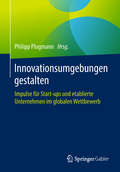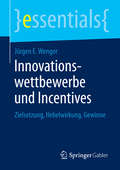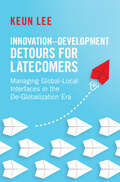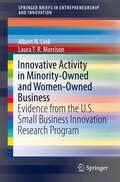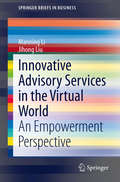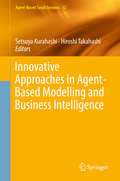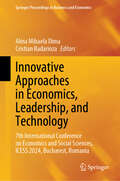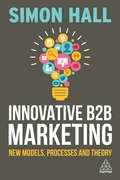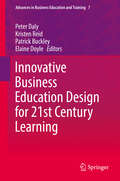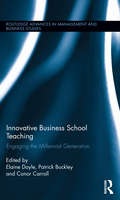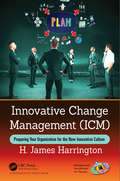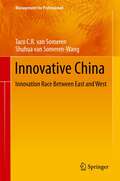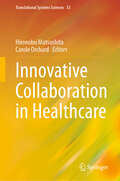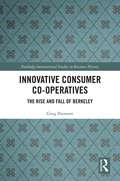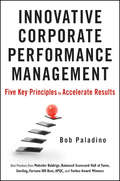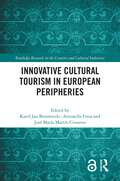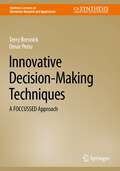- Table View
- List View
Innovationsstrategie: Die Brücke zur Unternehmenszukunft
by Daniel Huber Heiner Kaufmann Martin SteinmannDas Buch beschreibt theoretisch fundiert und praxisnah, wie mit neuen strategischen Werkzeugen eine Innovationstrategie systematisch erarbeitet wird, um auf diese Weise die langfristige Wettbewerbsfähigkeit eines Unternehmens zu sichern. Die strategischen Grundlagen für Innovation werden schrittweise und leicht verständlich mit einem Innovation-Framework entwickelt.Im neuen Strategieverständnis ist eine Unternehmensstrategie eine Two-Stars-Strategy. Sie besteht aus einem gegenwartsorientierten und einem zukunftsorientierten Teil. Unternehmen richten sich damit gleichzeitig auf zwei Zukunftssterne aus.Lernen auch Sie den Weg zum innovativen Unternehmen kennen und steigern Sie damit nachhaltig die Innovationsleistung und Zukunftsfähigkeit Ihres Unternehmens.
Innovationsumgebungen gestalten: Impulse für Start-ups und etablierte Unternehmen im globalen Wettbewerb
by Philipp PlugmannDie Ansicht, die deutsche Wirtschaft, samt der sogenannten Hidden Champions, wäre auf Jahrzehnte unangreifbar, ist eine riskante Wette auf die Zukunft. Entscheidend wird sein, wie innovativ die Unternehmen auch künftig sein werden und es bleiben. Wie man in seinem Unternehmen die Innovationsprozesse organisiert, die Ideen verwertet, Mitarbeiter aktiviert, Regeln aufstellt, Freiheiten einräumt und sich strukturiert, ist der jeweiligen Organisation überlassen, ist einzigartig und nur eingeschränkt planbar. Aber diese Innovationsumgebungen zu ermöglichen, ist eine unabdingbare Voraussetzung dafür, dass in Unternehmen Innovationen überhaupt entstehen und vorangetrieben werden können. Kombiniert mit einer positiv motivierenden Arbeitsatmosphäre, damit aus Neugier, Spieltrieb und Leistungsbereitschaft innovative Produkte und Dienstleistungen entwickelt werden können, bedarf es zusätzlich der Geschichten und Erfahrungen anderer Menschen bzw. aus interdisziplinärer Vernetzung. Die Beiträge in diesem Buch liefern Beispiele für gelingende Innovationsumgebungen, erzählen von besonderen Konstellationen und bieten so eine Reihe von frischen Impulsen für Unternehmer und Start-ups. Die Hidden Champions von heute werden auch die Champions von morgen bleiben, doch sollten wir langfristig übermorgen im Auge behalten.
Innovationswettbewerbe und Incentives: Zielsetzung, Hebelwirkung, Gewinne (essentials)
by Jürgen E. WengerDie Anzahl der Innovationswettbewerbe und deren weltweite Bedeutung nahmen in den letzten Jahren immer weiter zu. Insbesondere die Gewinne von Innovationswettbewerben sind mannigfaltig und von steigendem Wert. Viele kreative und engagierte Menschen in der ganzen Welt, aus allen Altersgruppen und Gesellschaftsschichten, nehmen an Innovationswettbewerben teil. Die Zielsetzung eines solchen Wettbewerbs kann sehr unterschiedlich sein. Auf Basis dieser verschiedenen Zielsetzungen werden sieben Grundtypen von Innovationswettbewerben hergeleitet. Dabei spielt die Gestaltung der Gewinne eine wichtige Rolle, denn diese bietet eine Möglichkeit zur Beeinflussung der Teilnahmebereitschaft, der Leistungsbereitschaft der Teilnehmer und der allgemeinen Attraktivität eines Innovationswettbewerbes.
Innovation–Development Detours for Latecomers: Managing Global-Local Interfaces in the De-Globalization Era
by Keun LeeMany developing countries still face difficulties initiating and sustaining economic development. Such difficulties have been exacerbated by the COVID-19 pandemic, resulting in an increasing divergence between rich and poor countries. One crucial question is whether to follow the trajectories of present-day rich countries or seek out different, new trajectories. Although this is a fundamental question, scholars offering mainstream prescriptions have not sufficiently explored it. Drawing on extensive empirical studies of firms and industries, Innovation and Development Detours for Latecomers proposes an effective alternative to prevailing development thinking. It presents a rich menu of development pathways, including a new role for Schumpeterian states whereby they do not follow the paths of technological development already taken by advanced countries. Rather, they can skip certain stages and even create their own detours thereby leapfrogging advanced countries in both manufacturing and service sectors. This title is also available as Open Access on Cambridge Core.
Innovation—The Missing Dimension
by Michael J. Piore Richard K. LesterAmid mounting concern over the loss of jobs to low-wage economies, one fact is clear: America's prosperity hinges on the ability of its businesses to continually introduce new products and services. But what makes for a creative economy? How can the remarkable surge of innovation that fueled the boom of the 1990s be sustained? For an answer, Richard K. Lester and Michael J. Piore examine innovation strategies in some of the economy's most dynamic sectors. Through eye-opening case studies of new product development in fields such as cell phones, medical devices, and blue jeans, two fundamental processes emerge. One of these processes, analysis--rational problem solving--dominates management and engineering practice. The other, interpretation, is not widely understood, or even recognized--although, as the authors make clear, it is absolutely crucial to innovation. Unlike problem solving, interpretation embraces and exploits ambiguity, the wellspring of creativity in the economy. By emphasizing interpretation, and showing how these two radically different processes can be combined, Lester and Piore's book gives managers and designers the concepts and tools to keep new products flowing. But the authors also offer an unsettling critique of national policy. By ignoring the role of interpretation, economic policymakers are drawing the wrong lessons from the 1990s boom. The current emphasis on expanding the reach of market competition will help the analytical processes needed to implement innovation. But if unchecked it risks choking off the economy's vital interpretive spaces. Unless a more balanced policy approach is adopted, warn Lester and Piore, America's capacity to innovate--its greatest economic asset--will erode.
Innovative Activity in Minority-Owned and Women-Owned Business: Evidence from the U.S. Small Business Innovation Research Program (SpringerBriefs in Entrepreneurship and Innovation)
by Albert N. Link Laura T. MorrisonThis volume examines the involvement of minority- or women-owned businesses in technology-based research, with particular focus on the differences in research outcomes in achieving commercialization. Specifically, the authors empirically investigate the correlation between technologies from projects funded through the Phase II Small Business Innovation Research (SBIR) program and the minority or gender demographics of the owners of the businesses conducting the research. This study offers an opportunity to not only examine public-sector agencies’ investments in research, but also to investigate if there are race and/or gender gaps in such business’ participation in innovative activities. It also provides a means to understand innovation by minorities and women in the entrepreneurial ecosystem. Investments in fundamental science and technology research and investments in human capital through science, technology, engineering, and mathematics (STEM) education are important building blocks of innovation. Two methods of fueling innovation are to 1) accelerate the commercialization of federally funded research and 2) ensure opportunities for underrepresented minorities and women in the entrepreneurial ecosystem. Despite this understanding, there is still a disparity in the rates of educated men and women in STEM fields participating in entrepreneurship. Moreover, the link between underrepresentation of minorities and women across STEM fields correlates with entrepreneurial entry and performance. This book expands on these findings and estimates the probability that (1) a funded research project reaches completion, (2) the developed technology is commercialized, and finally (3) the commercialized technology is successful in the marketplace (i.e., the business gained revenue and market share from the technology).
Innovative Advisory Services in the Virtual World
by Manning Li Jihong LiuHow to effectively design and deliver virtual advisory services can be a mystery to many public and private organisations. This study examines the interesting phenomenon of providing virtual advisors to assist users in accomplishing their tasks in the digital world. Based on a thorough analysis of abundant typical applications in various business and government sectors, this book discusses the current status and future trends of virtual advisory services in digital environments. This book also reveals exactly what users expect from such services, and what they hate! It provides thought-provoking guidelines for best practice in the design and provision of virtual advisors on e-portals.
Innovative Approach for the Development of Sustainable Settlements in East Africa: Affordable Housing for Mogadishu (Research for Development)
by Oscar Eugenio Bellini Andrea Campioli Claudio Del Pero Cinzia M. L. Talamo Davide Chiaroni Stefano Guidarini Camillo MagniThis book deals with sustainable affordable housing in developing countries, providing the main results of the BECOMe research project of the Politecnico di Milano. Sustainable, affordable housing in developing countries is increasingly important for African and international stakeholders, with massive urbanization processes involving many countries consuming large territories and natural resources minus any strategy of sustainability and social equality and without consideration of the long-term effects on the environment and subsequent generations. While the issue of affordable housing requires approaches adapted to the many specific African contexts, the case of Somalia seems representative of a fragile context characterized by the uncertainty of the social, political, and economic situations and the lack of common shared legislative references and strategies. The book aims to provide knowledge and propose a methodological framework developed from this particular situation that can serve as a template. On the basis of this main objective, the book deals with approaches and problems related to the creation of sustainable housing ecosystems, activating and boosting local enterprises and stimulating foreign investors to revamp the national AEC sector and related manufacturing industries, models for modular settlements, and business models and assessment methodologies useful for evaluating a set of appropriate technological solutions. Chapters 03 and 07 are available open access under a Creative Commons Attribution 4.0 International License via link.springer.com.
Innovative Approaches in Agent-Based Modelling and Business Intelligence (Agent-Based Social Systems #12)
by Setsuya Kurahashi Hiroshi TakahashiThis book thoroughly prepares intermediate-level readers for research in social science, organization studies, economics, finance, marketing science, and business science as complex adaptive systems. It presents the advantages of social simulation studies and business intelligence to those who are not familiar with the computational research approach, and offers experienced modelers various instructive examples of using agent-based modeling and business intelligence approaches to inspire their own work. In addition, the book discusses cutting-edge techniques for complex adaptive systems using their applications.To date, business science studies have focused only on data science and analyses of business problems. However, using these studies to enhance the capabilities of conventional techniques in the fields has not been investigated adequately. This book addresses managing the issues of societies, firms, and organizations to profit from interaction with agent-based modeling, human- and computer- mixed systems, and business intelligence approaches, an area that is fundamental for complex but bounded rational business environments.With detailed research by leading authors in the field, Innovative Approaches in Agent-Based Modelling and Business Intelligence inspires readers to join with other disciplines and extend the scope of the book with their own unique contributions. It also includes the common challenges encountered in computational social science and business science to enable researchers, students, and professionals to resolve their own problems.
Innovative Approaches in Economics, Leadership, and Technology: 7th International Conference on Economics and Social Sciences, ICESS 2024, Bucharest, Romania (Springer Proceedings in Business and Economics)
by Alina Mihaela Dima Cristian BadarinzaThis book presents a collection of topics that reflect the evolving landscape of economics, leadership, technology, and social systems in an interconnected world. From the role of accounting in supporting the United Nations Sustainable Development Goals (SDGs) to the complex interplay of transfer pricing regulations, tax compliance, and public perception, it covers critical issues shaping global financial practices. By investigating leadership at multinational companies through the dual lenses of cultural dynamics and artificial intelligence and underscoring the growing significance of digital networks in the global economy, the book fosters a rich, cross-disciplinary dialogue. Based on papers presented at the 7th International Conference on Economics and Social Sciences (ICESS 2024), held in Bucharest, Romania, the book offers a valuable asset for scholars, practitioners, and anyone interested in the future of global economic and social systems.
Innovative B2B Marketing: New Models, Processes and Theory
by Simon HallInnovative B2B Marketing is a clear, practical guide that demystifies modern aspects of B2B marketing, including marketing models, processes and thought leadership pieces. New customer buying habits, the digital era and the new industry landscape (influenced by the application economy) have all had a great impact, with marketing professionals consequently facing a shift away from traditional practices. The focus of Innovative B2B Marketing is to cut through the noise and make sense of the new models, methods and processes that have recently emerged in the B2B marketing sphere. Authored by Simon Hall, an ex-CMO who brings over 20 years' senior level experience as one of the leading voices in the B2B sphere actively working with the CIM, the IDM, and other major associations, Innovative B2B Marketing brings together a wealth of insight and information sourced from the author's own first-hand experience. Featuring real-life examples from diverse sectors, plus topical discussion points and problems from key B2B marketing forums and associations, marketers will find new approaches, models and solutions to help deal with any B2B marketing challenge.
Innovative B2B Marketing: New Models, Processes and Theory
by Simon HallNavigate the B2B marketing sphere with this fully updated guide on how to better understand new customer habits, the digital era and how to shift away from outdated traditional practices. Innovative B2B Marketing is an essential guide for marketers looking for the latest approaches, models and solutions for B2B marketing. Written by one of the leading voices in the B2B marketing sphere who works with the Chartered Institute of Marketing (CIM) and other major associations, this book features real-life examples from a diverse range of sectors including marine, information technology and pharmaceutical, plus topical discussion points and challenges from key B2B marketing forums and associations. Now fully updated, the second edition of Innovative B2B Marketing features new chapters on customer attrition, B2B partnership marketing and lead nurturing, as well as further content on influencer marketing and the behaviours of millennial customers. It is accompanied by online resources which consist of case studies, web links to insightful videos and articles, and presentation slides with practical models and templates.
Innovative Business Development—A Global Perspective: 25th International Economic Conference of Sibiu (IECS 2018) (Springer Proceedings in Business and Economics)
by Silvia Cristina Mărginean Claudia Ogrean Ramona OrășteanThis proceedings volume presents the latest trends in innovative business development theory and practice from a global, interdisciplinary perspective. Featuring selected contributions from the 25th International Economic Conference Sibiu (IECS 2018) held in Sibiu, Romania, it explores various topics in the areas of economics, business, finance and accounting, including tourism, marketing and Islamic banking and finance. Written by researchers from different regions and sectors around the world, it offers significant insights into the emerging shifts that characterize the fields of innovative economics and global development, innovative business practices, as well as innovative finance and banking, and provides organizations, managers and policy makers with new reliable solutions and opportunities for innovative development and growth within and between organizations around the globe.
Innovative Business Education Design for 21st Century Learning
by Patrick Buckley Peter Daly Kristen Reid Elaine DoyleThis volume explores two aspects of change within higher education: macro factors governing and influencing the institutional environment, and micro issues taking place within the institutions themselves. The first part of the book examines some of the micro issues that influence business and economics pedagogy. It presents reflections and analyses of teaching roles and values, the enhancement of the student learning experience with technology and real world experiences, and what students want and need to learn. The second part of the book looks at the wider institutional environment of change - the shifts in values, new stakeholders, and a change of focus toward developing skills students need to succeed in business. The book highlights the inter-related nature of these changes and shows that both aspects are important in motivating and inspiring students to be able participants in a 21st century global society. Its focus on interdisciplinarity, curriculum structures, and changing stakeholders helps to analyse the roles and models of business and economics education in addressing the needs of today's global environment.
Innovative Business School Teaching: Engaging the Millennial Generation (Routledge Advances in Management and Business Studies #56)
by Patrick Buckley Elaine Doyle Conor CarrollInnovative Business School Teaching showcases the latest pedagogic innovations that actively engage the millennial generation in learning within the business domain. In the context of the contemporary macro issues facing higher education, this book presents the latest teaching practices and tools used in higher education business teaching, clearly illustrating the practical ways in which business teachers can confront current pedagogic challenges. All of the contributors to this edited book have outstanding track records in teaching, having won national and international awards for teaching excellence, as well as publishing widely on pedagogy. Best practice teaching from multiple jurisdictions across a broad spectrum of business schools is represented. Each contributor shares their innovative teaching tools and techniques in a manner that emphasises how these tools can be adapted to other contexts, thus providing readers with an invaluable teaching resource.
Innovative CSR: From Risk Management to Value Creation
by Walter Leal Filho Samuel O. Idowu Céline LoucheBy and large, corporations of the 21st century have come to realise that their obligations to societies in terms of corporate social responsibility are fourfold: economic, ethical, altruistic and strategic. Meeting these four responsibilities is crucial to their survival in their various markets and industries; it also requires them to rewrite their previously less socially responsible business models in order to do so. All indications continue to suggest that it is those organisations that are perceived to be socially responsible by stakeholders in modern markets that survive and prosper. Corporations have equally realised that by being innovative in all things – including their CSR activities and initiatives – they will add value to the so-called bottom line, to the positive contributions they make to society and to how they are perceived by their key stakeholders. However, many criticisms have been made of CSR in its current form, often related to the lack of value that it generates within the enterprise and the fact that it offers only a partial and short-term response to the full challenges of sustainable development. The time has come to shift the CSR focus away from risk management towards a more progressive and entrepreneurial approach that seeks to create value and identify sustainable opportunities for strategic innovation. This book aims to explore, inspire and support creative, innovative and strategic CSR. "Innovation" in this book means new products, services and technologies and, in addition, new organisational and institutional systems, structures and new business models that empower the organisation to advance strategically in an ever more competitive business world. Both research and practice show that CSR has mainly been approached in terms of value protection and risk management, where the main objective has been to protect companies' existing assets or avoid scandals. Therefore, in many cases where CSR remains at the forefront of business activity, it does not lead to fundamental changes and is not yet integrated as a strategic component where it could create value, generate new ideas and open new opportunities. How do corporate entities shift their attention from risk management to value creation? This is the key question that this book attempts to answer, both theoretically and empirically as well as through real case studies and experiences. With contributions from a crème de la crème of scholars from 12 countries, Innovative CSR gathers together a cornucopia of innovative practices that will be essential reading for academics and practitioners alike.
Innovative Change Management: Preparing Your Organization for the New Innovative Culture (Management Handbooks for Results)
by H. James HarringtonInnovative Change Management (ICM) represents the accumulated wisdom and knowledge of one of the world’s foremost performance improvement specialists. It includes a clear and thorough explanation of the necessary critical tools for creating a system that results in a much higher percentage of your initiatives progressing to successful projects. Studies conducted by organizations such as Gartner, Ernst & Young, and Harrington Management Systems indicate that on average less than 25% of the innovative projects achieve sustained success. The American Productivity Quality Center's 2018 survey report pointed out that 88% of the organizations felt that process management discipline must be changed and 53.8% felt they must create a continuous improvement culture. Through the effective use of the ICM methodology, you can turn thousands of lost employee hours into millions of dollars in increased profit. This book unveils to the reader for the first time how ICM combines project change management, culture change management, and project management concepts to create an effective and innovative organization. These concepts combined result in homogeneous improvements in performance improvement and cultural change. The book outlines a step-by-step procedure designed to apply ICM to complex programs such as process redesign and supply chain management as well as to simpler ones such as relocation of offices. In addition, it provides field-tested change methodologies to help you systematically include change into your strategic management plan. This book shows you how to: Set the stage for ICM. Develop a new management style that encourages innovation. Develop and implement a project change management methodology to support the project management methodology. Develop a cultural change management program. How to reward and recognize the innovation activities generated by your employees. Make ICM an important part of the strategic plan. Help employees understand the career-enhancing aspects of change How to maximize your organization’s ROC (return on change). Most of the activity related to change management focuses on successfully implementing individual projects. Statistics indicate that this is not enough to keep up with today’s rapid changing innovative competition. As most profitable organizations are working diligently on increasing their innovation capabilities, this focus is requiring a completely new restructured management style and behavioral patterns that are foreign to most of today’s successful managers.
Innovative China
by Taco C.R. Someren Shuhua van Someren-WangChina is trying to turn its labor, capital and resources intensive, lower added-value and export dependent growth into a sustainable innovative economy. This is changing the world's power balance and has sparked a race between East and West in knowledge-based, high added-value economic innovation. Inspired by their extensive experience in doing business with China, the authors show how the US, the EU and China have reached a crossroad where ten battle fields decide about their future earning capacity and prosperity. Whether China will be a threat or an opportunity depends on the main players in government, public and private organizations rethinking their innovation policies and paths of business development. This books offers a new view on innovation which can be applied by corporate leaders and policy makers to get ready for the future.
Innovative China: New Drivers of Growth
by Development Research Center of the State Council;World Bank GroupAfter more than three decades of average annual growth close to 10 percent, China's economy is transitioning to a 'new normal' of slower but more balanced and sustainable growth. Its old drivers of growth -- a growing labor force, the migration from rural areas to cities, high levels of investments, and expanding exports -- are waning or having less impact. China's policymakers are well aware that the country needs new drivers of growth. This report proposes a reform agenda that emphasizes productivity and innovation to help policymakers promote China's future growth and achieve their vision of a modern and innovative China. The reform agenda is based on the three D's: removing Distortions to strengthen market competition and enhance the efficient allocation of resources in the economy; accelerating Diffusion of advanced technologies and management practices in China's economy, taking advantage of the large remaining potential for catch-up growth; and fostering Discovery and nurturing China's competitive and innovative capacity as China approaches OECD incomes in the decades ahead and extends the global innovation and technology frontier.
Innovative Collaboration in Healthcare (Translational Systems Sciences #33)
by Hironobu Matsushita Carole OrchardThis book is the first to approach collaboration in healthcare from a translational systems science perspective. There is a complex intertwining of collaborative relationships between diverse sectors, industries, universities, professions, teams, patients, and machines and robots powered by artificial intelligence and big data. Innovative collaboration is evolving both in the real world and in the virtual space of the Internet. While respecting patient-centeredness, collaboration is required in various settings and under different contexts such as hospitals, communities, use of new technology development, integrating industry academia-hospital-government relationships, through interprofessional approaches. However, it is only recently that “collaboration” in health professions has begun to be researched and discussed scientifically. The purpose of this book is to review and recapture “innovative collaboration” in modern healthcare, primarily from the perspective of translational systems science. To attain our goal, the authors have prepared three unique perspectives. The first is interprofessional collaboration. The elegance, sturdiness, and resilience of the tapestry depend heavily on cooperation between professions and the multisector. The second angle is patient-centeredness. In recent years, “patient-centeredness” has become an established motto, but to what extent is patient-centeredness, including ethics, realized in collaboration? We would like to introduce advanced approach. The third perspective is man-machine collaboration. Collaboration with robots and sensor systems connected to artificial intelligence and big data is becoming more common in all aspects of healthcare. While introducing advanced cases, the authors would like to critically analyze the ethics and conflicts that tend to hide behind the scenes.
Innovative Consumer Co-operatives: The Rise and Fall of Berkeley (Routledge International Studies in Business History)
by Greg PatmoreConsumer co-operatives provide a different approach to organizing business through their ideals of member ownership and democratic practice. Every co-operative member has an equal vote regardless of his or her own personal capital investment. The co-operative movement can also be an important force in promoting development and self-sufficiency in poorer areas, particularly in non-industrialised countries. This book explores in depth the fortunes of the Berkeley Consumer Co-operative, which became the largest consumer co-operative in the United States with 116,000 members in 1984 and viewed nationally as a leader in innovative retail practices and a champion of consumer rights. The Berkeley Consumer Co-operative is promoted by both supporters and opponents of the co-operative business model as a significant example of what can go wrong with the co-operatives. This book will provide the first in depth analysis of the history of the Berkeley Co-operative using its substantial but little used archives and oral histories to explore what the Berkeley experience means for the co-operative business model. The specific chapters relating to Berkeley will be organised around particular themes to highlight the issues relating to the co-operative business model and the local context of Berkeley. The themes relate to developments in Berkeley and the Bay Area in terms of the economy, politics and the retail environment; the management of the Berkeley co-operative, looking at governance, financial management and strategic decisions; relationship of management with members and employees; and finally, the relationship of the Berkeley Co-operative with the community. The core message of the book is that it is not inevitable that consumer co-operatives fail, but that the story of Berkeley story can provide insights that can strengthen the co-operative business model and minimise failures on the scale of Berkeley occurring in the future.
Innovative Corporate Performance Management
by Bob PaladinoAward-winning strategies to drive game changing meaningful results during the most challenging economy in decadesDrawing from executive and thought leader Bob Paladino's research and advisory experiences and collaboration with award-winning and high-performing organizations, this sequel his global best seller Innovative Corporate Performance Management: Five Key Principles to Accelerate Results provides a clear road map for executing enterprise strategy.Reveals a proven implementation model that has accelerated breakthrough resultsShares over 40 new, innovative best practices common to Malcolm Baldrige, Balanced Scorecard Hall of Fame, Sterling quality, Fortune 100 Best, APQC, and Forbes award winnersProvides a CPM Process Blueprint and diagnostic to score your organization and establish a plan for your award winning performanceOffers a fresh approach to integrating proven methodologies proven by case companies that have been awarded over 100 awardsIncludes key process maps, strategic planning frameworks, strategy maps, customer and competitor intelligence methods, balanced scorecards, comparative tables, project plans, testimonials, charts, graphs, and screen shots of CPM, CRM, BSC and KM systemsAll-new case studies and best practice research are included from world-renowned enterprises as well as insights from executives who have won the most globally recognized awards in business.
Innovative Cultural Tourism in European Peripheries (Routledge Research in the Creative and Cultural Industries)
by Karol Jan Borowiecki Antonella Fresa Civantos, José María MartínCultural tourism can play an important role in social and territorial cohesion. Focusing on European peripheral regions, this book illuminates the importance of local communities in heritage management for sustainable development.This book provides insights into the use of innovative business models and tools, such as ecosystem services contracts and digital narrative platforms, to enhance the sustainability and economic development of peripheral and marginal destinations. Additionally, this book addresses the value of data collection and analysis in cultural tourism and provides insights into participatory models and approaches that contribute to sustainable tourism development.With contributions from a pan‑European range of expert scholars and practitioners, this book serves as an essential resource for researchers, professionals, and anyone with an interest in tourism, and the cultural and creative industries.The Open Access version of thi book, available at www.taylorfrancis.com, has been made available under a Creative Commons Attribution-Non Commercial- No Derivatives (CC-BY-NC-ND) 4.0 license.
Innovative Decision-Making Techniques: A FOCCUSSED Approach (Synthesis Lectures on Operations Research and Applications)
by Terry Bresnick Omar PeriuThis book provides a blend of quantitative and qualitative approaches to decision making, while also bridging the gap between the theory of how to make good decisions versus how people actually make decisions. The authors present the tools and techniques of decision analysis to learn how to become a FOCCUSSED decision maker: Identify and properly Frame the decision or problem at handSpecify the goals, Objectives, and values that you are trying to achieveDevelop creative, meaningful Choices from among which you can chooseEvaluate the Consequences of selecting each alternative using your goals, objectives, and valuesThink about the key Uncertainties that could impact the decisionUnderstand the Swaps and trade-offs that you are willing to makeDevelop an approach for implementing your SolutionElicit the data you’ll need from a variety of sourcesand Disseminate and communicate your decisions to others. The authors define a decision as the choice among alternatives, based on how we value and trade-off their pros and cons, made in the face of uncertainty about what will actually happen. The decision-making process is presented as having three pillars to support the decision maker: Preferences–what we prefer, what meets our goals and objectives, and the recognition that preferences are personal to the one making the decision; Alternatives–the choices, options, or courses of action that we have, and over which we have some degree of control; and Information–what we know about the situation, what we don’t know, how we connect choices to outcomes, and how we deal with uncertainty. Key components of good decision-making include how to define your goals and objectives, how to incorporate uncertainties that we all face, and how to develop better alternatives, all of which are discussed. Sophisticated techniques are presented in a way that is accessible to the average decision maker. Probability theory is utilized to improve decisions, and uncertainties are captured in decision trees. Risk avoidance, risk transfer, and risk mitigation are also discussed. Readers will gain a clear understanding of how to articulate the goals and objectives that should be the focal point of any decision.
Innovative Design of Manufacturing: Compiled By Project Team Of Research On Strategic Development Of Innovative Design (Springer Tracts in Mechanical Engineering)
by Yongxiang Lu Yunhe Pan Zhilei XuWith the implementation of the strategic plan “Made in China 2025” as its guideline and “the study of formulation of executive summary of innovative design in the manufacturing industry” as the main theme, this book provides an in-depth interpretation of innovative design from three perspectives – why, what and how. Chapter One, “The Necessity of Developing Innovative Design,” focuses on why innovative design should be developed, and Chapter Two, “Concept And Connotation of Innovative Design,” explains what innovative design is, while Chapters Three to Seven systematically and comprehensively discuss how to develop innovative design and how to improve innovative design skills in various contexts, including key industries, business, personnel training, platform building, and supporting measures. Lastly, Chapter Eight “Cases of Innovative Design” explores the value of innovative design and innovative design-driven industrial transformation. By analyzing several design-driven companies, such as China Railway Rolling Stock Corporation, Haier Group and GAG Trumpchi, and the role of corporate innovative development as well as typical examples of major innovative design projects, it offers readers insights and inspiration.

